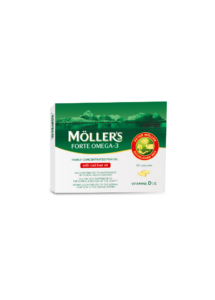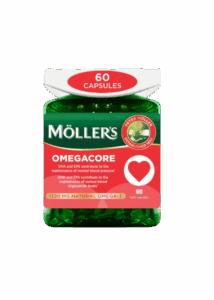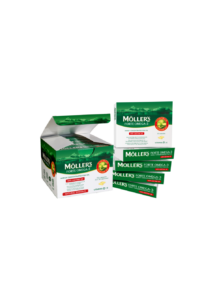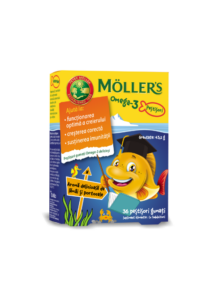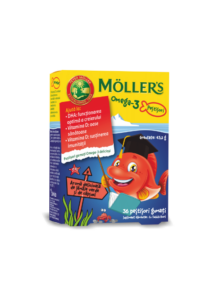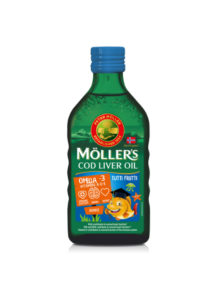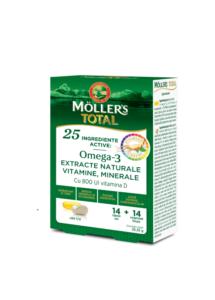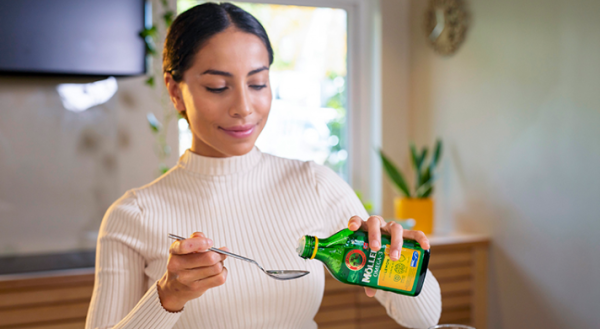Omega-3 i vitamin D važni su nutrijenti o kojima ovisi optimalno funkcioniranje našeg organizma. No kako zapravo ovi vitalni nutrijenti djeluju u tijelu?
Home » Omega-3 i vitamin D – dva važna nutrijenta

Omega-3 i vitamin D – u čemu je razlika?
Premda neke namirnice i dodaci prehrani, poput ribe i Möller’s ulja jetre bakalara, sadrže i omega-3 i vitamin D, ovi se nutrijenti nalaze zasebno i u različitim namirnicama biljnog i životinjskog podrijetla.
Omega-3 za srce, mozak i vid
Istraživanja pokazuju da omega-3 masne kiseline EPA i DHA sudjeluju u ključnim procesima u tijelu, poput izgradnje kardiovaskularnog sustava, što znači da imaju pozitivan učinak na zdravlje srca. Masna kiselina DHA posebno je važna jer doprinosi normalnom razvoju i održavanju funkcije mozga i očiju. Također, istraživanja pokazuju povezanost između majčina unosa DHA tijekom trudnoće i pravilnog razvoja mozga fetusa te ulogu DHA u održavanju moždanih funkcija tijekom života.
Vitamin D
Vitamin D nalazi se u namirnicama poput masne ribe, riblje ikre i dodataka prehrani kao što je Möller’s ulje jetre bakalara. Najčešći oblici vitamina D su D2 i D3, od kojih je D3 poželjniji jer ga tijelo lakše apsorbira i koristi. Dok se vitamin D2 nalazi u biljkama, primjerice u gljivama, vitamin D3 je prisutan u namirnicama životinjskog podrijetla.
Vitamin D važan je za pravilan razvoj kostiju kod djece, održavanje normalne funkcije imunološkog sustava i zdrave koštane strukture tijekom cijelog života.
Više članaka o vitaminima i mineralima pročitajte ovdje.
Omega-3 i vitamin D – koliko je potrebno?
Zdravstvene institucije jasno su definirale preporučeni dnevni unos vitamina D:
Bebama do 1. godine života preporučuje se 8,5 do 10 mikrograma vitamina D dnevno.
Djeci starijoj od 1 godine i odraslima preporučuje se 10 mikrograma vitamina D dnevno, uključujući trudnice, dojilje i osobe s povećanim rizikom od manjka vitamina D.
Od kraja ožujka do kraja rujna većina ljudi dobiva dovoljno vitamina D putem izlaganja suncu. Međutim, tijekom jeseni i zime potrebno je vitamin D unositi putem prehrane ili dodataka prehrani, budući da hrana često ne može osigurati dovoljne količine. Stoga se preporučuje uzimanje dodataka prehrani s 10 mikrograma vitamina D dnevno tijekom jeseni i zime.
Također se preporučuje najmanje dva obroka masne ribe tjedno (ukupno 300–450 g ribe), od čega bi 200 grama trebala biti masna riba poput lososa, pastrve, skuše ili haringe. Primjerice, losos sadrži oko 2,4 grama omega-3 masnih kiselina EPA i DHA na 100 grama. Da biste osigurali dovoljan unos EPA i DHA, preporučuje se dnevno unijeti oko 250 mg ovih masnih kiselina.
What is good health?
Do you have a good lifestyle?
Lifestyle simply means the way in which you live. Health and lifestyle go hand in hand. You might feel you have a good lifestyle if you are physically active, eat healthily and generally experience a sense of wellbeing. Conversely, if you want good health you should also have a good lifestyle.
Physical activity is the major contributor to a good lifestyle, but diet, drugs, stress, sleep and social conditions are also play an important role. Being able to use the body properly to avoid injury also affects lifestyle. Physical activity can also prevent depression and help you to recover more quickly from mental illness, both of which obviously affect your lifestyle.
Diet can be a difficult topic for many. Perhaps you eat too much or too little or maybe you find it hard to know what foods to combine to have a balanced diet. It’s also important to eat food that contains important vitamins, minerals and dietary fibre, omega-3 and antioxidants. On top of all this, you also need to get enough energy, protein and the correct fatty acids. The requirement for these nutrients changes throughout your life. When you are older you also have different requirements than children and younger adults. Women also have different requirements than men. Pregnant and breastfeeding mothers also have special requirements.
When you get older, you lose muscle mass and your body requires less energy and therefore less food. You may lead a less active life than you did before, which is why you require less food. However, your need for minerals, vitamins and other nutrients remains the same. Of course, there are plenty of healthy and active older people, but when you reach 70 to 80 years of age, it’s easier to become ill, especially during flu season.
Some steps you can take to improve your lifestyle and health are to:
- eat a healthy and varied diet
- stay active
- watch your weight
- avoid too much alcohol and don’t smoke
- get enough sleep
- think positive
- practise good hygiene
What is good quality of life?
The World Health Organisation (WHO) defines quality of life as a state where the individual can realise their potential, cope with normal stressful situations, work in a rewarding and positive way, and be able to contribute to others and society.
Quality of life is a wide and somewhat diffuse concept that includes joy in, and a desire for, life. These are values that are rather felt than measured, which in turn are based on personal environment and choices. Quality of life doesn’t necessarily depend on being healthy or sick. It’s the moments between worries, sorrows, problems and ailments that matter. For example, if you have a chronic illness, a feeling of mastery can be important when talking about quality of life.
To sum up, quality of life is a combination of health, lifestyle, networks and social support. It’s about experiencing joy, meaning in life, satisfaction, security and a sense of belonging, as well as being able to use your strengths. It’s also about feeling interest in life, coping with everyday situations and a being committed to something or someone. If you have good quality of life, you will be able to cope better with the inevitable stressful situations in life.
Naši proizvodi
MÖLLER'S FORTE OMEGA 30 kapsule
MÖLLER'S OMEGACORE
MÖLLER'S FORTE OMEGA 150 kapsule
MÖLLER'S OMEGA 3 RIBICE s okusom NARANČE I LIMUNA
MÖLLER'S OMEGA 3 RIBICE s okusom JAGODE
MÖLLER'S OMEGA 3 RIBICE s okusom COLE
MÖLLER'S OMEGA 3 ULJE JETRE BAKALARA s okusom TUTTI FRUTTI
MÖLLER'S OMEGA 3 ULJE JETRE BAKALARA s okusom LIMUNA
MÖLLER'S TOTAL
Saznajte više
Zašto Möller’s? Pouzdan i kvalitetan izvor omega-3 iz Norveške
imunitet omega-3
Dobro zdravlje, stil života i kvaliteta života – što to zapravo znači?
Ulje jetre bakalara ZDRAVO STARENJE
Ulje jetre bakalara i vaš imunološki sustav
imunološki sustav Ulje jetre bakalara
Pronađite inspiraciju na našem Instagramu
This error message is only visible to WordPress admins
Error: Access Token is not valid or has expired. Feed will not update.
